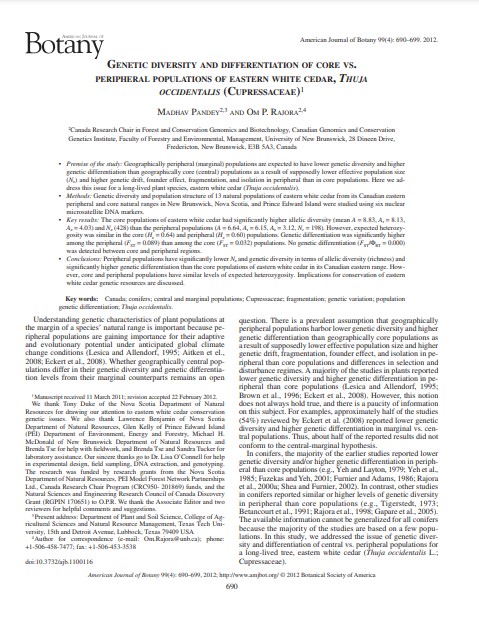GENETIC DIVERSITY AND DIFFERENTIATION OF CORE VS. PERIPHERAL POPULATIONS OF EASTERN WHITE CEDAR, THUJA OCCIDENTALIS (CUPRESSACEAE)
Bosque Modelo:
Nova Forest Alliance
Temática:
Conservación
Tipo de documento:
Artículo científico
Resumen
Premise of the study: Geographically peripheral (marginal) populations are expected to have lower genetic diversity and higher genetic differentiation than geographically core (central) populations as a result of supposedly lower effective population size ( Ne ) and higher genetic drift, founder effect, fragmentation, and isolation in peripheral than in core populations. Here we address this issue for a long-lived plant species, eastern white cedar ( Thuja occidentalis ).
• Methods: Genetic diversity and population structure of 13 natural populations of eastern white cedar from its Canadian eastern peripheral and core natural ranges in New Brunswick, Nova Scotia, and Prince Edward Island were studied using six nuclear microsatellite DNA markers.
• Key results: The core populations of eastern white cedar had signifi cantly higher allelic diversity (mean A = 8.83, Ar = 8.13, Ae = 4.03) and Ne (428) than the peripheral populations ( A = 6.64, Ar = 6.15, Ae = 3.12, N e = 198). However, expected heterozygosity was similar in the core ( He = 0.64) and peripheral ( He = 0.60) populations. Genetic differentiation was signifi cantly higher among the peripheral ( FST = 0.089) than among the core ( FST = 0.032) populations. No genetic differentiation ( FST /ΦRT = 0.000) was detected between core and peripheral regions.
• Conclusions: Peripheral populations have signifi cantly lower Ne and genetic diversity in terms of allelic diversity (richness) and significantly higher genetic differentiation than the core populations of eastern white cedar in its Canadian eastern range. However, core and peripheral populations have similar levels of expected heterozygosity. Implications for conservation of eastern white cedar genetic resources are discussed.
Información Bibliográfica
Autor:
Pandey, Madhav; Rajora, Om P.
Revista:
AMERICAN JOURNAL OF BOTANY
Año:
2012
N°:
4
País :
Canadá
Páginas:
690 - 699
Volumen:
99
Idioma:
Ingles
Palabras claves
Canada; conifers; central and marginal populations; Cupressaceae; fragmentation; genetic variation; population genetic differentiation; Thuja occidentalis .





